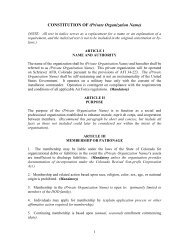310TH SPACE WING (AFRC) (310 SW) - Schriever Air Force Base
310TH SPACE WING (AFRC) (310 SW) - Schriever Air Force Base
310TH SPACE WING (AFRC) (310 SW) - Schriever Air Force Base
Create successful ePaper yourself
Turn your PDF publications into a flip-book with our unique Google optimized e-Paper software.
14<br />
to essential sites or guaranteeing deployed tactical forces large<br />
data trunks, Milstar’s unique waveform places it at the lead of<br />
the family of protected SATCOM services, reserved for the<br />
highest priority communications.<br />
A key goal of Milstar is to provide interoperability between<br />
<strong>Air</strong> <strong>Force</strong>, Army, Marine and Navy users. Using Milstar,<br />
mobile ground forces, ships, submarines and aircraft are<br />
linked to achieve joint operations with survivable, protected<br />
communication onthe modern battlefi eld.<br />
Milstar’s employment of centralized management and<br />
decentralized execution is exercised through this intelligent<br />
payload, and other features like steerable antennas, so users<br />
can setup communications with minimal interface to outside<br />
agencies. Th e Milstar payloads provide low data rate services<br />
from 75 to 2,400 bits per second, as well as medium data rate<br />
services from 4.8 to 1,544 kilobits per second. Additionally,<br />
the constellation introduced cross-linking capabilities to the<br />
SATCOM community, allowing worldwide connectivity<br />
without the need to intermediate retransmission stations.<br />
Th e satellite weighs approximately 10,000 pounds and has<br />
a geosynchronous orbit altitude of more than 22,000 miles<br />
and a design life of 10 years.<br />
AEHF<br />
Th e Advanced Extremely High Frequency System is a<br />
joint service satellite communications system that will provide<br />
survivable, global, secure, and protected communications for<br />
high-priority military ground, sea and air assets. AEHF will<br />
allow the National Security Council and Unifi ed Combatant<br />
Commanders to control their tactical and strategic forces at all<br />
levels of confl ict through general nuclear war and supports the<br />
attainment of information superiority.<br />
Th e AEHF System is the follow-on to the Milstar system,<br />
augmenting and improving on the capabilities of Milstar,<br />
and expanding the MILSATCOM architecture. AEHF will<br />
provide connectivity across the spectrum of mission areas,<br />
including land, air and naval warfare; special operations;<br />
strategic nuclear operations; strategic defense; theater missile<br />
defense; and space operations and intelligence. AEHF 1 was<br />
launched on Aug. 14, 2010<br />
Th e system will consist of four satellites in geosynchronous<br />
earth orbit (GEO) that provides 10 times the throughput of<br />
the 1990s-era Milstar satellites with a substantial increase in<br />
coverage for users. First launched in August 2010, AEHF<br />
will provide continuous 24-hour coverage between 65<br />
degrees north and 65 degrees south latitude. Th e AEHF<br />
system is composed of three segments: space (the satellites),<br />
ground (mission control and associated communications<br />
links) and terminals (the users). Th e segments will provide<br />
communications in a specifi ed set of data rates from 75 bps<br />
to approximately 8 Mbps. Th e space segment consists of<br />
a cross-linked constellation of four satellites. Th e mission<br />
control segment controls satellites on orbit, monitors satellite<br />
health and provides communications system planning and<br />
monitoring. Th is segment is highly survivable, with both fi xed<br />
and mobile control stations. System uplinks and crosslinks<br />
will operate in the extremely high frequency (EHF) range<br />
and downlinks in the super high frequency (SHF) range.<br />
Th e terminal segment includes fi xed and ground mobile<br />
terminals, ship and submarine terminals, and airborne<br />
terminals used by all of the Services, as well as international<br />
partners (Canada, Netherlands and UK). MILSATCOM is<br />
responsible for acquisition of the space and ground segments<br />
as well as the <strong>Air</strong> <strong>Force</strong> terminal segments.<br />
Detachment 1<br />
Th e 50th Operations Group, Detachment 1 is located just<br />
minutes away from the Nation’s capital at the National Oceanic<br />
and Atmospheric Administration Satellite Operations<br />
Facility in Suitland, MD. Detachment 1 provides oversight<br />
for all operations, maintenance, sustainment, and acquisition<br />
activities associated with the Defense Meteorological<br />
Satellite Program. Detachment 1 partners with the 6th Space<br />
Operations Squadron which provides backup command and<br />
control for the DMSP satellite constellation. Detachment<br />
1 was activated on Jan. 20, 2011 following closure of the<br />
National Polar Orbiting Environmental Satellite System<br />
program offi ce. DMSP is the DoD’s sole weather satellite,<br />
providing critical data to agencies such as <strong>Air</strong> <strong>Force</strong> Weather<br />
Agency, Fleet Numerical Meteorological and Oceanography<br />
Center, National Weather Service, Joint Typhoon Warning<br />
Center, National Ice Center, NASA, and warfi ghters around<br />
the globe.<br />
©2012 Benchmark Publications, Inc.














